Manuscripts Etc.
| CLOSE WINDOW |

|
The following items are drawn from the William Faulkner Foundation Collection at the University of Virginia's Albert and Shirley Small Special Collections Library (http://small.library.virginia.edu/). |
|
The story of how Requiem for a Nun was written is an unusually roundabout one. Faulkner first began thinking about a book with that title - "a good title, I think," he wrote his publisher - in 1933. It was going to be about an African American woman, and "a little on the esoteric side," but though he wrote several pages under the title before putting the manuscript aside, not much else is known about his intentions. A decade later, working on movie scripts in Hollywood, he encountered Ruth Ford, an actress from Mississippi with whom he wanted to have an affair; she told him her dream was to have him write a play for her. That project didn't crystalize, however, until he began thinking about collaborating on a piece of writing with Joan Williams, a Bard college student with whom he also hoped to have an affair. In February, 1950, he checked into the Algonquin Hotel in New York - still famous for its writers' "round table" in the 1920s - to meet with Random House about a collected edition of his stories, and while in the city he spent time socially with both these women. According to Joseph Blotner, he began writing a play on the train back to Oxford, re-using that old title - and perhaps aspects of the story he'd conceived 17 years earlier - in what he now imagined as a play. The fragment of Algonquin stationery below records an early stage in that process, though how early is not clear: the outline includes both "Temple" and "Gowan" in the cast, and it wasn't until March that he decided to include Temple in the play, and perhaps even later that he decided on Gowan (as you'll see). 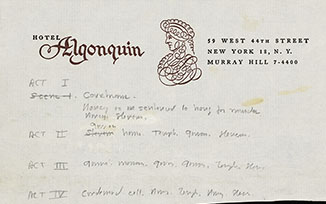 The 38-page manuscript of the play in the Faulkner Papers at Virginia includes pieces from multiple drafts, as Faulkner used both sides of the legal pad paper he was writing on, and at some point or another in the writing process cancelled all the pages on both sides. The two pages below, which seem to have been written consecutively though that's not unambiguous, indicate one version of the play's dramatic opening when Nancy Mannigoe is, as the outline above puts it, "sentenced to hang for murder." "Temple" is mentioned by name on page 2 (below right), but she is not among the characters listed on page 1 (below left) - and more confusingly, when on page 2 the scene changes "smoothly" between the courtroom and the "home" that the outline first says belongs to "Stevens," but then changes to "Gowan," the man to whom Temple is married is named "Todd." 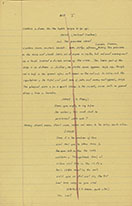 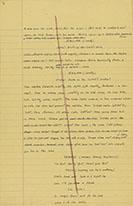 Faulkner drew the central characters in the play from two earlier texts. In answer to a question at the University of Virginia in 1957, Faulkner said that Nancy Mannigoe "is the same person" as the Nancy (no last name) in the short story "That Evening Sun," where she is a servant in the Compson household; Faulkner added that all his characters "belong to me, and I have the right to move them about in time when I need them." Temple nee Drake was the young University Mississippi student whom Popeye rapes in Sanctuary, after she was abandoned at the derelict Old Frenchman place by Gowan Stevens. This is the grim story Faulkner tells in Sanctuary. Gavin Stevens, who like Nancy was cast for a part in the drama from the beginning, was by 1950 just about Faulkner's favorite character; he had already appeared in a dozen stories and novels - though not Sanctuary, despite the way the play assumes he was part of Temple's ordeal in that earlier novel. (The character who was there in the role that Gavin claims to have played was Horace Benbow, a major character in two of Faulkner's first Yoknapatawpha novels but only mentioned once after Sanctuary.) Gowan disappears (in disgrace) from Yoknapatawpha before the end of Sanctuary, and is not mentioned again until his eventual return in Requiem, which is the first time Faulkner establishes a familial relationship between him and Gavin. There is in fact no hint of any possible marriage between Temple and anyone in Sanctuary, though Faulkner told two different audiences at Virginia that at least one origin of Requiem was his curiosity about how, after what happens in Sanctuary, the marriage between Temple and "a weak man" - presumably Gowan - would turn out. But the pages below make it clear that at least at least one version of the play did not originally include Gowan at all. There is no character named "Todd" in any of Faulkner's published works, but he's at least two versions of the manuscript. Below left: Todd is clearly at home when, with Temple and Stevens, he returns from the trial. Center: page 6 seems to record the moment at which "Todd" becomes "Gowan," though whether this means that we see Faulkner abruptly re-conceiving the relationship between Requiem and Sanctuary at this moment is not clear. Right: if you look closely at Gowan's first speech on page 7, you can see the "T" of Todd's name under the G of Gowan's. From this point on in the manuscript, Temple's husband is definitely Gowan, though many aspects of the character, including his sobriety since the events in Sanctuary, are not present yet. 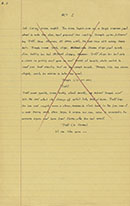 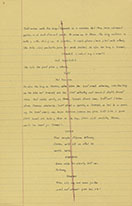 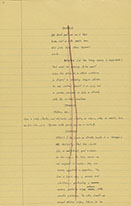 It's not easy to say where these discrepancies leave us. There's no reason to doubt that when he decided to include Temple in the play he was writing about Nancy, he intended to bring the events of Sanctuary into the plot. More than once Faulkner forgets a character's name when he brings someone back from an earlier text. It's possible that he mistakenly remembered the young man who abandoned Temple as Todd, though the two different manuscript versions of the play's opening scenes indicate that if this was simply Faulkner's lapse, it survived into at least one revision. The manuscript pages that survive don't include any backstory for "Todd"s marriage to Temple, so there's simply no way to tell how the full story of Requiem's dramatic portions might have been different if Faulkner had not re-named Temple's husband Gowan. (For more on the novel's composition, see the Note on the Text.) SOURCES: Joseph Blotner, Faulkner: A Biography; Blotner, ed.Selected Letters of William Faulkner. Citing this source: |
